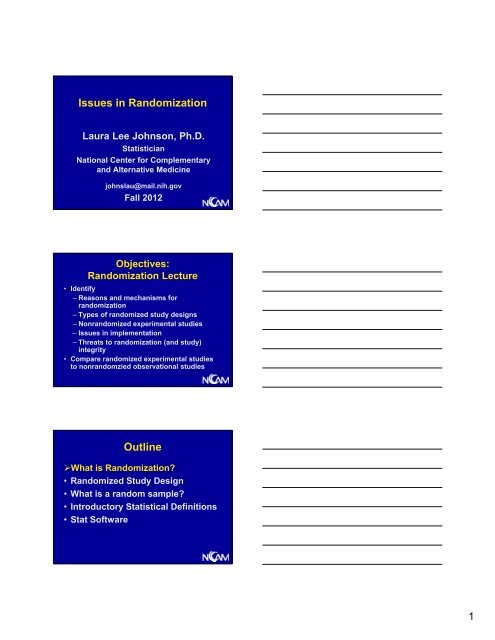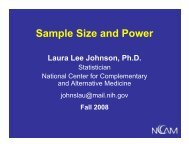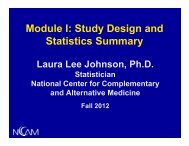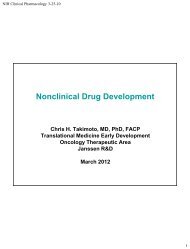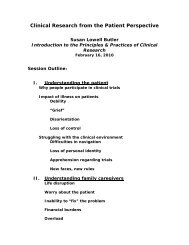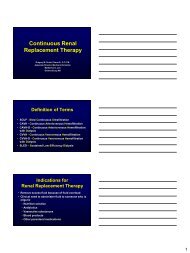Issues in Randomization Outline
Issues in Randomization Outline
Issues in Randomization Outline
Create successful ePaper yourself
Turn your PDF publications into a flip-book with our unique Google optimized e-Paper software.
<strong>Issues</strong> <strong>in</strong> <strong>Randomization</strong>Laura Lee Johnson, Ph.D.StatisticianNational Center for Complementaryand Alternative Medic<strong>in</strong>ejohnslau@mail.nih.govFall 2012Objectives:<strong>Randomization</strong> Lecture• Identify– Reasons and mechanisms forrandomization– Types of randomized study designs– Nonrandomized experimental studies– <strong>Issues</strong> <strong>in</strong> implementation– Threats to randomization (and study)<strong>in</strong>tegrity• Compare randomized experimental studiesto nonrandomzied observational studiesOutl<strong>in</strong>e‣What is <strong>Randomization</strong>?• Randomized Study Design• What is a random sample?p• Introductory Statistical Def<strong>in</strong>itions• Stat Software1
What do we mean by random?• Everyday speech– Process is random if there is no discernablepattern• Statistics– Random characterizes a process ofselection that is governed by a knownprobability rule for example 2 treatmentshave equal chance of be<strong>in</strong>g assigned– Random <strong>in</strong> statistics does not meanhaphazard4What is random treatmentallocation?“By random allocation, we mean that eachpatient has a known chance, usually equalchance, of be<strong>in</strong>g given each treatment, butthe treatment to be given cannot bepredicted.” (Altman 1991)5What is random treatmentallocation?• <strong>Randomization</strong> is the act of allocat<strong>in</strong>g arandom treatment assignment• A patient is said to be randomized to atreatment arm or group when they areassigned to the treatment group us<strong>in</strong>grandom allocation• Cl<strong>in</strong>ical trials that use random treatmentallocation are referred to as randomizedcl<strong>in</strong>ical trials62
Random Sample vs.<strong>Randomization</strong>• Random sample: chancedeterm<strong>in</strong>es who will be IN thesample• <strong>Randomization</strong>: chance determ<strong>in</strong>esthe ASSIGNMENT of treatmentBasic• Two (or more) different treatments that wewant to compare<strong>Randomization</strong>: Def<strong>in</strong>ition• Not a random sample• Random Allocation– Known chance receiv<strong>in</strong>g a treatment– Cannot predict the treatment to be given• Elim<strong>in</strong>ate Selection Bias– Outcome measurements can be biased• Similar Treatment Groups– Does not elim<strong>in</strong>ate basel<strong>in</strong>e differences– If basel<strong>in</strong>e differences they arose bychance3
ONE Factor is Different• <strong>Randomization</strong> tries to ensure thatONLY ONE factor is different betweentwo or more groups.– Chance if 80% women <strong>in</strong> one group and20% <strong>in</strong> the other• Observe the Consequences• Attribute Causality• In truth, a rarity and cannot testWays to Randomize• Standard ways:– Random number tables (see text)– Computer programs– randomization.com• Three randomization plan generators• NOT legitimate– Birth date– Last digit of the medical record number– Odd/even room numberWho/What to Randomize - Independence• Person– Common unit of randomization <strong>in</strong> RCTs– Might take several biopsies/person• Provider– Doctor – Doctor– Nurs<strong>in</strong>g station• Locality– School– Community• Sample size is predom<strong>in</strong>antly determ<strong>in</strong>ed bythe number of randomized units4
Should I Randomize?Almost Always YES; But Pitfalls• Small sample size• Rare condition• Rare confound<strong>in</strong>g factors• People do what they want anyway– Test<strong>in</strong>g Life as practiced! (at your localgym, drug or health food store)– Wikipedia killed some bl<strong>in</strong>d<strong>in</strong>g/mask<strong>in</strong>g• Post randomization exposed non-randomly– Medication mix up and control group getswrong <strong>in</strong>vestigational agentTypes of <strong>Randomization</strong>• Simple• Blocked <strong>Randomization</strong>• Stratified <strong>Randomization</strong>• Basel<strong>in</strong>e Covariate Adaptive<strong>Randomization</strong>/Allocation• Response Adaptive <strong>Randomization</strong> orAllocation (us<strong>in</strong>g <strong>in</strong>terim data)• Cluster <strong>Randomization</strong>Simple <strong>Randomization</strong>• Randomize each patient to atreatment with a known probability– Corresponds to flipp<strong>in</strong>g a co<strong>in</strong>• Could have imbalance <strong>in</strong> # / groupor trends <strong>in</strong> group assignment• Could have different distributionsof a trait like gender <strong>in</strong> the twoarms5
Block <strong>Randomization</strong>• Insure the # of patients assigned toeach treatment is not far out of balance– Block size = 6, 2 study <strong>in</strong>terventions (Aand B)• AAABBB, BAABAB, ABABAB….• Variable block size (permuted)– An additional layer of bl<strong>in</strong>dness• Different distributions of a trait likegender <strong>in</strong> the two arms possibleStratified <strong>Randomization</strong>• A priori certa<strong>in</strong> factors likelyimportant (e.g. Age, Gender)• Randomize so different levels ofthe factor are BALANCED betweentreatment groups• Cannot evaluate the stratificationvariableStratified <strong>Randomization</strong>• For each subgroup or strataperform a separate blockrandomization• Common strata– Cl<strong>in</strong>ical center, Age, Gender• Stratification MUST be taken <strong>in</strong>toaccount <strong>in</strong> the data analysis!6
Stratified Block <strong>Randomization</strong> ExamplePreexposure Prophylaxis Initiative (iPrEx) Trial• Double-bl<strong>in</strong>ded placebo-controlledrandomized trial exam<strong>in</strong><strong>in</strong>g efficacy of achemoprophylaxis regimen for HIV prevention• International multi-center study– Multiple advantages to achiev<strong>in</strong>g balancedallocation by site• 2499 HIV- men or transgender women wererandomly assigned <strong>in</strong> blocks of 10, stratifiedaccord<strong>in</strong>g to siteNEJM 2010 v363 (27): 2587-259919Adaptive <strong>Randomization</strong>• Previously discussed randomization methodsexamples of fixed allocation schemes– Order of treatment assignments can becompletely determ<strong>in</strong>ed <strong>in</strong> advance of trial• Adaptive randomization schemes “adapt” orchange accord<strong>in</strong>g to characteristics ofsubjects enrolled <strong>in</strong> trial• Note not all adaptive trials <strong>in</strong>volve adaptiverandomization, namely group sequential trials20Adaptive <strong>Randomization</strong>• Sequence of treatment assignments cannotbe determ<strong>in</strong>ed <strong>in</strong> advance• Probability of assign<strong>in</strong>g a new participant aparticular treatment can change over time• Two major classes– Adaptive with respect to basel<strong>in</strong>echaracteristics– Adaptive with respect to patient outcomes217
Adaptive ?<strong>Randomization</strong>?Same Title, Different Mean<strong>in</strong>gs• Basel<strong>in</strong>e Covariate– M<strong>in</strong>imization/Dynamic allocation– Pocock & Simon; Brad Efron (biasedco<strong>in</strong>)• Adaptive <strong>Randomization</strong>/Allocation– Us<strong>in</strong>g <strong>in</strong>terim outcome data– Play the w<strong>in</strong>ner or 2-armed bandit– BayesianBasel<strong>in</strong>e Covariate Adaptive<strong>Randomization</strong>/Allocation• M<strong>in</strong>imization/Dynamic Allocation– Balance on the marg<strong>in</strong>s• Table 1 looks pretty– Does not promise overall treatmentarms balanced <strong>in</strong> #• Pocock & Simon (biased co<strong>in</strong>)– Basel<strong>in</strong>e covariates– Weighted probability (not 50/50)Why not just stratify?• Typically, many many variables• Will not have people <strong>in</strong> each “cell”if do traditional stratification– How many participants• Pittsburgh Site, Male, 40-64,• AND Grade 2, hormone therapy, 6-18 mopost treatment,• AND……8
Eye-Open<strong>in</strong>g Experiencefor M<strong>in</strong>imization• Late Onset Treatment Study (LOTS)– 90 patients with late onset Pompe disease– Van der Ploeg et al (2010) NEJM 362, 1396-1406• For more details about statistical problemsm<strong>in</strong>imization caused, see– Proschan, M., Britta<strong>in</strong>, E., andKammerman, L. (2011). M<strong>in</strong>imize the useof m<strong>in</strong>imization with unequal allocation.Biometrics 67, 1135-114125Response Adaptive<strong>Randomization</strong>/Allocation• Outcome data dur<strong>in</strong>g trial (<strong>in</strong>terim)• Unbalance # / arm <strong>in</strong> favor of the‘better’ treatment(s)– Ethically appeal<strong>in</strong>g to some• Difficult to do well– Computer programm<strong>in</strong>g, not simple– All bl<strong>in</strong>ded but statisticianAdaptive <strong>Randomization</strong>Difficult• Programm<strong>in</strong>g is not easy• All bl<strong>in</strong>ded but statistician• Ignore covariates– Unknown can lead to problems– Treatment-covariate <strong>in</strong>teractions• Imbalances may be backwards with<strong>in</strong>subgroups– Time trends/drift9
Response Adaptive• May be group sequential designs• May use cont<strong>in</strong>uous <strong>in</strong>terimanalysis to feed <strong>in</strong>to randomization• May use set <strong>in</strong>terim i analysis timepo<strong>in</strong>ts to feed <strong>in</strong>to randomization• Do not want response to be toolong termCluster <strong>Randomization</strong>• Same ideas as before• Unit of randomization– School/Cl<strong>in</strong>ic/Hospitals– Providers• Outcome measurement– Students– Patients• Need to use special models for analysisbecause those provid<strong>in</strong>g outcomesnested <strong>in</strong> unit that was randomizedWhat do I recommend?• Depends on the study andresources available• My go-to for researchers– Permuted block randomization– Stratified by site– Choose block size(s) appropriate tosample size– Randomize smallest <strong>in</strong>dependentelement at last possible second10
Example• Try this at home!– Or at NIH Thursday even<strong>in</strong>g session(sign up with Benita Bazemore)• Bags of hard shell chocolate candyExample• How many bags?• Different sizes of bags?• Number of types of candy?• Number of colors <strong>in</strong> each?11
<strong>Randomization</strong> Example• N = 56 (nice small study size)• Different types of randomization• 2 arm study• 6 colors: red, orange, yellow, blue,green, black• Compare to N = 20 exampleSimple <strong>Randomization</strong>• Perform a simple randomization• Record the results• Repeat as long as you have time(3-5 m<strong>in</strong>utes)Simple <strong>Randomization</strong> #112
Randomize 56, 3 TimesSimple <strong>Randomization</strong>1 2 3N/arm 28:28Red 9 4:5Orange 8 4:4Yellow 3 2:1Blue 11 5:6Green 16 10:6Black 9 3:6Simple <strong>Randomization</strong> #2Randomize 56, 3 TimesSimple <strong>Randomization</strong>1 2 3N/arm 28:28 38:18Red 9 4:5 6:3Orange 8 4:4 7:1Yellow 3 2:1 1:2Blue 11 5:6 5:6Green 16 10:6 10:6Black 9 3:6 9:013
Randomize 56, 3 TimesSimple <strong>Randomization</strong>1 2 3N/arm 28:28 38:18 17:39Red 9 4:5 6:3 2:7Orange 8 4:4 7:1 4:4Yellow 3 2:1 1:2 1:2Blue 11 5:6 5:6 3:8Green 16 10:6 10:6 4:12Black 9 3:6 9:0 3:6Randomize 20, 5 TimesSimple <strong>Randomization</strong>1 2 3 4 5N/arm 9:11 9:11 11:9 6:14 14:6Red 4 2:2 2:2 2:2 0:4 3:1Orange 5 1:4 2:3 2:3 2:3 4:1Yellow 4 2:2 2:2 3:1 0:4 2:2Blue 2 2:0 1:1 1:1 1:1 2:0Green 3 1:2 1:2 2:1 1:2 2:1Black 2 1:1 1:1 1:1 2:0 1:1Block <strong>Randomization</strong>• Try aga<strong>in</strong>• Use (simple) Block <strong>Randomization</strong>14
Simple Block <strong>Randomization</strong>Randomize 56, BlocksBlockN/arm 28:28Red 5:4Orange 3:5Yellow 0:3Blue 8:3Green 7:9Black 5:4Permuted Block <strong>Randomization</strong>15
Permuted Block <strong>Randomization</strong>Randomize 56, BlocksBlock PermutedBlockN/arm 28:28 28:28Red 5:4 4:5Orange 3:5 5:3Yellow 0:3 3:0Blue 8:3 3:8Green 7:9 8:8Black 5:4 5:4Stratified Permuted Block<strong>Randomization</strong>16
Stratified Permuted Block<strong>Randomization</strong>Randomize 56, BlocksBlockPermutedBlockStratifiedPerm. Bl.N/arm 28:28 28:28 28:28Red 5:4 4:5 5:4Orange 3:5 5:3 4:4Yellow 0:3 3:0 2:1Blue 8:3 3:8 5:6Green 7:9 8:8 8:8Black 5:4 5:4 4:5Randomize 20, BlocksBlockPermutedBlockStratifiedPerm. Bl.N/arm 10:10 10:10 10:10Red 2:2 2:2 2:2Orange 2:3 2:3 2:3Yellow 3:1 3:1 2:2Blue 2:0 1:1 1:1Green 1:2 1:2 2:1Black 0:2 1:1 1:117
Many Ways to Randomize• Choose one– Appropriate to sample size– Choose block size(s) appropriate tosample size• If I have to choose one– Permuted block randomization• Stratified by siteTime to Randomize?• When the treatment must change!• SWOG: 1 vs. 2 years of CMFVPadjuvant chemotherapy <strong>in</strong> axillarynode-positive and estrogenreceptor-negative patients.– JCO, Vol 11 No. 9 (Sept), 1993Randomize at the Time TrialArms Diverge• SWOG randomized at beg<strong>in</strong>n<strong>in</strong>g oftreatment• Discont<strong>in</strong>ued treatment beforerelapse or death– 17% on 1 year arm– 59% on 2 year arm– Ma<strong>in</strong> reason was patient refusal18
Even if 2 weeks later?• Long term use of beta blockerspost MI• 393 randomized 2 weeks prior tostart<strong>in</strong>g therapy• 162 patients treated– 69 beta blocker– 93 placeboRandomized, Treated, Analyzed• 393 randomized• 162 patients treated• “…appears to be an effective formof secondary therapy ….”– Paper reported on analysis of n=162• What about the 231 randomizedbut dropped from the analysis?Intent to Treat vs. Completers• ITT = Intent To Treat analysis– Assume all study participants• Adhered to the study regime assigned• Completed the study– Only analysis to preserve randomization• MITT = Modified ITT analysis– ITT, but only <strong>in</strong>clude people who take thefirst dosage• Per Protocol-Completers-Adherers analysis– Only the well behaved19
Take Home• Permuted block randomization– Stratified by site– Appropriate to sample size– Choose block size(s) appropriate tosample size• Randomize smallest <strong>in</strong>dependentelement at last possible second• ITT (<strong>in</strong>tent to treat) analysisOutl<strong>in</strong>eWhat is <strong>Randomization</strong>?‣Randomized Study Design• What is a random sample?• Introductory Statistical Def<strong>in</strong>itions• Stat SoftwareStudy Design Taxonomy• Randomized vs. Non-Randomized• Bl<strong>in</strong>ded/Masked or Not– S<strong>in</strong>gle-bl<strong>in</strong>d, Double bl<strong>in</strong>d, Unbl<strong>in</strong>ded• Treatment vs. Observational• Prospective vs. Retrospective• Longitud<strong>in</strong>al vs. Cross-sectional20
Ideal Study - Gold Standard• Randomized• Double bl<strong>in</strong>d / masked• Treatment• Prospective• Parallel groupsTypes of Randomized Studies• Parallel Group - classic• Sequential Trials – physical sciences• Group Sequential trials - classic• Cross-over – very useful if useable• Factorial Designs - <strong>in</strong>dependence• Adaptive Designs – ga<strong>in</strong><strong>in</strong>g popularityThreats to <strong>Randomization</strong>Integrity• Improper mask<strong>in</strong>g or bl<strong>in</strong>d<strong>in</strong>g– Bias will creep <strong>in</strong>to data• Exclud<strong>in</strong>g subjects who withdraw fromtreatment– Can lead to bias• Drop-out/miss<strong>in</strong>g data– Without ITT: Breaks randomization– With ITT: Weakens treatment result– Long trials may need to have a screen<strong>in</strong>gperiod to assess commitment of subjectsbefore randomization6321
Simple Important Steps to Avoid Problems• Check eligibility criteria thoroughly prior toenrollment– Unnecessary drop out if realize afterrandomization subject not eligible andforced to withdraw– No matter how quickly a subject iswithdrawn all randomized subjects <strong>in</strong>cluded<strong>in</strong> ITT• Avoid a delay between randomization andtreatment <strong>in</strong>itiation– Delays can lead to unnecessary miss<strong>in</strong>gdata that affects ITT64Documentation• Protocol should specify who ma<strong>in</strong>ta<strong>in</strong>s/hasaccess to unbl<strong>in</strong>ded treatment assignment– Protocol should also specify criteria forunmask<strong>in</strong>g and treatment of earlywithdrawals• There should be documentation of therandomization algorithm, randomization list,and how it was implemented– Reproducibility is key65Possible Implementations of Bl<strong>in</strong>ded<strong>Randomization</strong>• Sequenced sealed envelopes– Prone to tamper<strong>in</strong>g!• Sequenced bottles/packets– Generally carried out by pharmacy/drugcompany• Phone call to central location– Live response, IVRS (Voice ResponseSystem)• On site computer system• Web based• Best plans easily messed up <strong>in</strong> implementation22
Outl<strong>in</strong>eWhat is <strong>Randomization</strong>?Randomized Study Design‣What is a random sample?• Introductory Statistical Def<strong>in</strong>itions• Stat SoftwareRandom Sample• Draw from the population• Use a probability device• Select names out of a hat– Now randomize them to treatmentassignments• A few types of sampl<strong>in</strong>g to get names<strong>in</strong>to the hat (not randomization)– Simple– Stratified– ClusterSimple Random Sample• Every possible subject chosenfrom a population for <strong>in</strong>vestigationhas an equal chance of be<strong>in</strong>gselected from the population• Stop laugh<strong>in</strong>g23
Stratified Sampl<strong>in</strong>g• Select <strong>in</strong>dependent samples• Number of subpopulations,groups, strata with<strong>in</strong> thepopulation• Might ga<strong>in</strong> efficiency if donejudiciouslyCluster Sampl<strong>in</strong>g• Sample <strong>in</strong> groups• Need to look at <strong>in</strong>tra-clustercorrelation<strong>Randomization</strong> Conclusions• Permuted block randomization– Stratified by site– Appropriate to sample size– Block size(s) appropriate to sample size• Randomize smallest <strong>in</strong>dependent element atlast possible second• Mask<strong>in</strong>g/bl<strong>in</strong>d<strong>in</strong>g is also key• ITT (<strong>in</strong>tent to treat) analysis• Analyze as you randomize• Proper documentation and implementation24
Outl<strong>in</strong>eWhat is <strong>Randomization</strong>?Randomized Study DesignWhat is a random sample?‣Introductory Statistical Def<strong>in</strong>itions• Stat SoftwareVocabulary• Sample size: N or n– May refer to total or per group!• Mean: average; sum / n• Median: 50%; middle ordered value• Variance: σ 2 (population) or s 2 (sample)• Standard deviation: σ or s• Standard error: σ/√n or s/√nVocabulary• Odds ratio• Relative risk• Proportion: ranges 0 to 1– For example 45% = 0.45• A|B is said, “A Given B”– P(A|B): “If B is true, what is the probabilityof A?” or “What is the probability of Agiven B is true?”25
Vocabulary• Y i = β 0 + β 1 x 1i + ε i• Y = outcome or response variable– Might not be an actual response• X = covariate, variable• β 0 = <strong>in</strong>tercept– Average value of Y when X = 0• β 1 = slope, coefficient• ε = error, residual, difference betweensample fit or prediction and personY i = β 0 + β 1 x 1i + ε i• Subscript ‘i’ is person i; i = 15– Y 15 = 119 (SBP); x 15 = 1 (on treatment)• Y = β 0 + β 1 x 1 general sample model– Say β 0 = 150, β 1 = -20• Y 15 = β 0 + β 1 x 15 + ε 15– Thus 119 = 150 – 20*1 + ε 15– So ε 15 = 119 – 150 + 20 = -11– Difference between Y 15 and modelpredicted Y 15 = -11Vocabulary• Statistic: Compute from sample• Sampl<strong>in</strong>g Distribution– All possible values statistic can have– Samples of a given size randomly drawnfrom the same population• Parameter: Compute from population– Usually unknown to researcher– Several large studies <strong>in</strong> population26
Studies: Early, Stages, Phases• Early studies, <strong>in</strong>termediate or midrange,Conclusive or Def<strong>in</strong>itive orLarge, Late stage– RCT (Randomized Controlled Trial)• Some are big, some are not• Phase 0-IV• Multistage• SeamlessPhase I to Phase IV Trials• National Cancer Institute: Dictionary of CancerTerms• Phase I - The first step <strong>in</strong> test<strong>in</strong>g anew treatment <strong>in</strong> humans• Test the best way to give a newtreatment (for example, by mouth,<strong>in</strong>travenous <strong>in</strong>fusion, or <strong>in</strong>jection)and the best dosePhase I• Dose <strong>in</strong>creased little at a time• F<strong>in</strong>d the highest dose that does not causeharmful side effects• Little known about possible risks andbenefits of the treatments be<strong>in</strong>g tested• Trials usually <strong>in</strong>clude only a small number ofpatients who have not been helped by othertreatments27
Blocked <strong>Randomization</strong> Example:Flu Vacc<strong>in</strong>e Dose Escalation Study• Phase I dose-f<strong>in</strong>d<strong>in</strong>g flu vacc<strong>in</strong>e study• Investigate 6 dose levels <strong>in</strong> a bl<strong>in</strong>ded,placebo controlled study– Considered s<strong>in</strong>gle (one nare) and doubledose (both nares) of 0.25mg, 0.5 mg, and1mg adm<strong>in</strong>istered <strong>in</strong>tranasally• Primary outcome: safety and tolerability82Blocked <strong>Randomization</strong> Example:Flu Vacc<strong>in</strong>e Dose Escalation Study• Dose cohorts had 5 active and 2 placebosubjects• Randomized block design, block of size 7• Order of the 5 active and 2 placeboassignments randomly permuted for eachdose group83Phase II• A study to test whether a new treatment hasan anticancer effect (for example, whether itshr<strong>in</strong>ks a tumor or improves blood testresults) and whether it works aga<strong>in</strong>st acerta<strong>in</strong> type of cancer• Surrogate endpo<strong>in</strong>ts– Note: many th<strong>in</strong>gs shr<strong>in</strong>k tumors and donot improve survival/quality of life(ACRT/SCTS story)28
Phase III• A study to compare the results ofpeople tak<strong>in</strong>g a new treatment withthe results of people tak<strong>in</strong>g thestandard d treatment t t (for example,which group has better survivalrates or fewer side effects)• “Def<strong>in</strong>itive”Phase IV• After a treatment has been approved and isbe<strong>in</strong>g marketed, it is studied <strong>in</strong> a phase IVtrial to evaluate side effects or other<strong>in</strong>dications or populations that were notapparent <strong>in</strong> the Phase III trial• Thousands of people are <strong>in</strong>volved <strong>in</strong> a PhaseIV trial• Different population from Phase III• Duration of useDist<strong>in</strong>guish“Observational studies are oftenanalyzed as if they had resultedfrom a controlled study, and yetthe tacit assumption ofrandomness can be crucial forthe validity of <strong>in</strong>ference.”Copas, J.B. and Li, H.G. (1997). Inference for non-randomsamples (with discussion).Journal of the Royal Statistical Society, 59: 55–95.29
Interest<strong>in</strong>g Intro Talk• http://ted.com/talks/view/id/1234• Fast talk<strong>in</strong>g but good <strong>in</strong>terest<strong>in</strong>g<strong>in</strong>tro to research design andresults <strong>in</strong>terpretationAnother Game?Random Example (Game 1)• Everybody get a co<strong>in</strong>– Designate one side “Heads” and theopposite side “Tails”• Flip the co<strong>in</strong>• How many heads (raise hands)• How are the heads clustered (vstails) clustered together?9030
Random Example (Game 2)• Everybody pick a random numberfrom this list0 1 2 3 4 5 6 7 8 9 1091Outl<strong>in</strong>eWhat is <strong>Randomization</strong>?Randomized Study DesignWhat is a random sample?Introductory Statistical Def<strong>in</strong>itions‣Stat SoftwareStatistical Resources• Software• Books• Articles• Colleagues• Internet31
Software• Most is expensive and some haveyearly license fees– NIH (through CIT) many times has thesoftware for free or cheaper thanretail; CDC and universities do, too• Some is hard to use, some is easySoftware: Programm<strong>in</strong>g Options• S-PLUS (W<strong>in</strong>dows/UNIX): Strongacademic and NIH follow<strong>in</strong>g;extensible; comprehensive– www.<strong>in</strong>sightful.com• R (W<strong>in</strong>dows/L<strong>in</strong>ux/UNIX/Mac): GNU;similar to S-PLUS– www.r-project.org– www.bioconductor.orgS+ and R• Produce well-designed publicationqualityplots• Code from C,C++, Fortran can becalled• Active user communities32
Other Software• STATA (W<strong>in</strong>dows/Mac/UNIX)– Good for general computation,survival, diagnostic test<strong>in</strong>g– Epi friendly– GUI/menu and command driven– Active user community– www.stata.comOther Software• SAS (W<strong>in</strong>dows/UNIX)– Command driven– Difficult to use, but very good onceyou know how to use it– Many users on the East coast– www.sas.com• SPSS, EpiCure, many othersStatistical Calculators• www.randomization.com• http://calculators.stat.ucla.edu/– “Statistical Calculators”– Down recently• http://statpages.org/• http://www.biostat.wisc.edu/landemets/• http://www.stat.uiowa.edu/~rlenth/Power33
Questions?34


